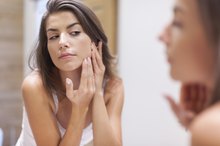How to Treat Pimples That Are Deep Under the Skin
While the direct cause of pimples is unknown, Brown University Health Education explains that hormones known as androgens and a person’s genetics may play a very large role 1. Pimples develop when oil and bacteria enter your pores. Within the pore, the bacteria continue to grow, trapping the oil. This process can occur just below the surface of your skin or deep within. Getting rid of a pimple deep under the skin requires the help of a warm compress to soften the plug and draw it to the surface.
Dampen a washcloth with warm water. Squeeze the washcloth to remove excess water.
How to Treat Boils With Tea Tree Oil
Learn More
Fold the washcloth in quarters and place it over the affected area. Allow the warm compress to rest on your skin for about 15 minutes to open your pore and help draw the trapped oil and bacteria to the surface.
Repeat the process several times a day. Within two to three days, the heat from the warm compresses should bring the deep pimple to a head. The oil and bacteria will then seep out of the pimple, relieving pressure and reducing redness.
Tips
Help prevent deep pimples from forming by washing your skin with a gentle cleanser in the morning and at night before you go to bed, suggests Brown University Health Education. If deep pimples are a reoccurring problem, see a dermatologist. He may prescribe topical medications that can relieve your symptoms and reduce outbreaks.
Warnings
Do not squeeze your pimples using your fingernails or fingertips, whether your pimple is deep or not. Doing so can cause damage to your skin, which may eventually result in scarring. Do not use hot water; warm water will suffice.
Related Articles
References
- Brown University Health Education: Acne
- Werschler WP, Herdener RS, Ross VE, Zimmerman E. Critical Considerations on Optimizing Topical Corticosteroid Therapy. J Clin Aesthet Dermatol. 2015;8(8 Suppl):S2-8.
- Tan AU, Schlosser BJ, Paller AS. A review of diagnosis and treatment of acne in adult female patients. Int J Womens Dermatol. 2018;4(2):56-71. doi:10.1016/j.ijwd.2017.10.006
- Song SW, Burm JS, Yang WY, Kang SY. Minimally invasive excision of epidermal cysts through a small hole made by a CO2 laser. Arch Plast Surg. 2014;41(1):85-8.
- Lee SJ, Hyun MY, Park KY, Kim BJ. A tip for performing intralesional triamcinolone acetonide injections in acne patients. J Am Acad Dermatol. 2014;71(4):e127-8. doi:10.1016/j.jaad.2014.04.030
- Aydin D, Hölmich LR, Jakobsen LP. Metastatic basal cell carcinoma caused by carcinoma misdiagnosed as acne - case report and literature review. Clin Case Rep. 2016;4(6):601-4. doi:10.1002/ccr3.575
- Gallitano SM, Berson DS. How acne bumps cause the blues: The influence of acne vulgaris on self-esteem. Int J Womens Dermatol. 2018;4(1):12-17. doi:10.1016/j.ijwd.2017.10.004
- "Questions and Answers About Acne." National Institute of Arthritis and Musculoskeletal and Skin Diseases (NIAMS). Jan 2006. National Institutes of Health.
- "Acne." AAD.org. American Academy of Dermatology, n.d. Web.
- Zaenglein AL, Pathy AL, Schlosser BJ, Alikhan A, Baldwin HE, et. al. "Guidelines of Care for the Management of Acne Vulgaris." Journal of the American Academy of Dermatology. 2016; 74(5): 945-73.
Writer Bio
Jonae Fredericks started writing in 2007. She also has a background as a licensed cosmetologist and certified skin-care specialist. Jonae Fredericks is a certified paraeducator, presently working in the public education system.








